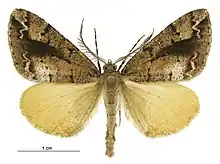Pseudocoremia amaculata
Pseudocoremia amaculata is a species of moth in the family Geometridae.[2] It is endemic to New Zealand and has been observed at St Arnaud. As at 2003 the female of this species is unknown. This species has been shown to be parasitised by species of wasps in the genera Aleiodes, Casinaria and Glyptapanteles.
| Pseudocoremia amaculata | |
|---|---|
 | |
| Male | |
| Scientific classification | |
| Domain: | Eukaryota |
| Kingdom: | Animalia |
| Phylum: | Arthropoda |
| Class: | Insecta |
| Order: | Lepidoptera |
| Family: | Geometridae |
| Genus: | Pseudocoremia |
| Species: | P. amaculata |
| Binomial name | |
| Pseudocoremia amaculata | |
Taxonomy
This species was first described by Andréa Stephens and George Gibbs in 2003.[3] J. S. Dugdale mentioned the species in his 1988 publication as one of two undescribed species in the genus Pseudocoremia.[4] The male holotype specimen collected by Dugdale at St Arnaud Village in 1983 is held at the New Zealand Arthropod Collection.[3]
Description
The forewing length of the male of this species is between 15 and 16 mm.[3] Stephens and Gibbs described the species as follows:
Forewings: relatively uniform medium brown across the entire surface, basal line and the median lines very faint, terminal line very faint zig-zag, below the apex across the terminal line is a darker brown poorly defined smear. Hindwings: completely yellow with no evidence of peppering. Antennae: bipectinate, with the longest pectinations extending to around 1875μm with pectinations becoming shorter towards the tip of the antennae, distal 22% of antennae without pectinations.[3]
As at 2003 the female of this species is unknown.[3]
Distribution
This species is endemic to New Zealand.[1][5] It has been collected only at St Arnaud.[3] Stephens and Gibbs mentioned a specimen collected at the Hapuka Scenic Reserve near Kaikōura that may be P. amaculata.[3] However, as a result of that specimen being more strongly marked there is doubt about this designation.[3]
Predators
This species has been studied and found to have been parasitised by species of wasps in the genera Aleiodes, Casinaria and Glyptapanteles.[7]
References
- "Pseudocoremia amaculata Stephens & Gibbs, 2003". www.nzor.org.nz. Retrieved 2022-04-29.
- Gordon, Dennis P., ed. (2010). New Zealand inventory of biodiversity: Kingdom animalia : chaetognatha, ecdysozoa, ichnofossils. Vol. 2. p. 459. ISBN 978-1-877257-93-3. OCLC 973607714. OL 25288394M. Wikidata Q45922947.
- Andréa E. A. Stephens; George W. Gibbs (December 2003). "Two new species of Pseudocoremia and reinstatement of P. pergrataas species (Lepidoptera: Geometridae: Ennominae)". New Zealand Entomologist. 26 (1): 61–64. doi:10.1080/00779962.2003.9722109. ISSN 0077-9962. Wikidata Q54601619.
- John Stewart Dugdale (23 September 1988). "Lepidoptera - annotated catalogue, and keys to family-group taxa". Fauna of New Zealand. Department of Scientific and Industrial Research. 14: 169. doi:10.7931/J2/FNZ.14. ISSN 0111-5383. Wikidata Q45083134.
- "Pseudocoremia amaculata Stephens & Gibbs, 2003". biotanz.landcareresearch.co.nz. 5 November 2015. Retrieved 2023-04-23.
- Robert J. B. Hoare (2014). A Photographic Guide to Moths & Butterflies of New Zealand. Illustrator: Olivier Jean-Philippe Ball. p. 112. ISBN 978-1-86966-399-5. Wikidata Q59396160.
- Frost, Carol M.; Peralta, Guadalupe; Rand, Tatyana A.; Didham, Raphael K.; Varsani, Arvind; Tylianakis, Jason M. (2016-08-31). "Apparent competition drives community-wide parasitism rates and changes in host abundance across ecosystem boundaries". Nature Communications. 7 (1): 12644. doi:10.1038/ncomms12644. ISSN 2041-1723. PMC 5013663. PMID 27577948.